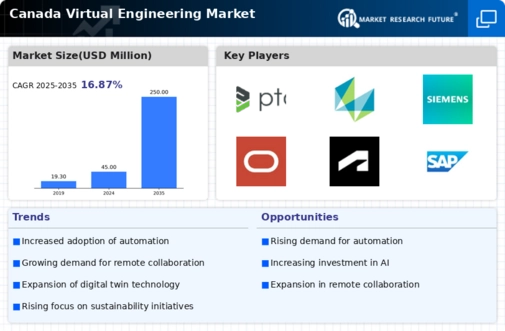The Canada Virtual Engineering Market has been experiencing notable growth driven by the increasing adoption of advanced simulation tools and digital twin technologies across various sectors. As industries recognize the benefits of virtual engineering such as cost reduction, improved efficiency, and enhanced innovation, competition has intensified among local and international players. The market landscape is characterized by a diverse array of companies offering solutions that facilitate virtual design, modeling, and testing processes. The integration of artificial intelligence and machine learning into virtual engineering is also reshaping the competitive dynamics, presenting both challenges and opportunities for companies vying for dominance in this burgeoning market.
In the context of the Canada Virtual Engineering Market, PTC has distinguished itself through its robust portfolio of innovative products specifically designed to meet the needs of this region. The company's strengths lie in its strong emphasis on digital transformation, leveraging technologies that enable businesses to enhance product development cycles and improve operational efficiencies. PTC's flagship offerings encompass augmented reality applications and computer-aided design (CAD) software, providing substantial value to clients across various industries such as manufacturing, aerospace, and automotive.
With a well-entrenched presence in Canada, PTC has established strategic partnerships and collaborations that bolster its competitive standing while also engaging in continuous efforts to optimize its service delivery and customer engagement capabilities, further solidifying its footprint in the virtual engineering landscape.Hexagon is another key player in the Canada Virtual Engineering Market, recognized for its sophisticated solutions that cater to different engineering sectors. The company's focus on smart manufacturing and digital reality solutions positions it as a leader in the integration of real-time data analytics into engineering processes.
Hexagon’s key products include measurement and visualization software, design simulation tools, and advanced manufacturing solutions, which are instrumental in enhancing product quality and operational efficiency. The company's strategic initiatives, including various mergers and acquisitions, have bolstered its capabilities and market reach within Canada, allowing it to offer tailored solutions that meet local industry demands. Hexagon's strengths lie in its ability to provide comprehensive, end-to-end solutions that integrate design, measurement, and manufacturing, paving the way for improved project outcomes and customer satisfaction in the region.






















Leave a Comment